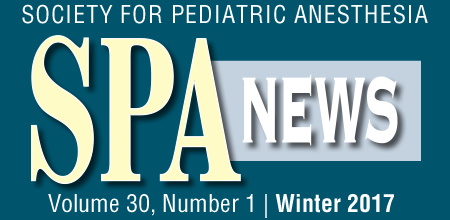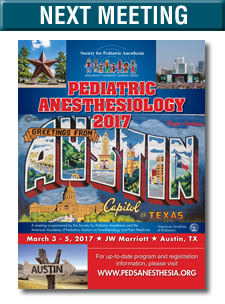Annual Meeting Reviews
Session V: Celebration of 30 Years
Reviewed by Michael Mulick, DO
Children’s Hospital Los Angeles
University of Southern California
Ground Control to Doctor Tom: Anesthesia at the Final Frontier
Matthieu Komorowski, MD (Imperial College - London and Massachusetts Institute of Technology) concluded this year’s fall meeting by presenting his research on performing anesthesia in space. No person has been anesthetized in space making this an important area for research and development. One might argue whether the cost of space research is justified. It costs $12 million to put a person in space, $1.5 billion to launch a shuttle, and $100 billion for building and launching the international space station (ISS). Furthermore, space exploration is dangerous and many people have died on space missions. Apart from the catastrophic risks of launch and re-entry, there are health risks related to the effects of microgravity, radiation, fluid shifts, and cardiovascular deconditioning.
There are many arguments for space exploration but none more important than to ensure survival of our species. Stephen Hawking and Elon Musk are two influential people who promote this belief. Stephen Hawking recently stated “I do not think the human race will survive the next thousand years unless we spread into space. There are too many accidents that can befall life on a single planet”. It’s a sobering thought. At the present time the only planet that we could consider sending a human would be Mars. Could what was once wildly ambitious science fiction fantasy now become an absolute necessity?
The Space Environment
We continue to learn about the space environment through work done by people living on the ISS (International Space Station) which is a large, habitable satellite that has been in low earth orbit (altitude 250 miles and velocity of 17,000 mph) since 1998. The conditions within the ISS are completely comfortable (temperature 23°C, 21% oxygen, barometric pressure of 101.3 kPa) and weightless. The conditions outside the ISS however are hostile where the temperature can vary from -120 to 150° C, the barometric pressure is 0kPa, and there are large amounts of solar and galactic radiation. Space debris or particles in space could collide with the ISS and destroy it at any time. Astronauts spend 6 months in the ISS which is equivalent to the expected time of a one way trip to Mars.
Missions to Mars proposals have been discussed for over 60 years. Elon Musk recently announced a plan to send people on reusable spacecrafts at as low a cost as possible. His goal is to send roughly 100 people at a time on the biggest ship ever made to yield 1 million people on Mars in roughly 40 to 100 years.
Human physiology in Space
It’s important to compare healthcare delivery on earth with that in space. On earth, we deal with patients that have pathological disease in a relatively unencumbered environment where human and technological resources are readily available. In space, we deal with perfectly heathy people (at least prior to launch) who now experience alterations in physiology due to microgravity or from trauma in an extremely difficult environment where technical and human resources are severely limited. For example, if there was at least one doctor on a mission to Mars, she could not be a specialist in all areas of medicine nor have all the equipment necessary to treat every medical condition.
Most serious or fatal accidents occur on launch and re-entry due to rapid changes in velocity exerting huge pressures on the spacecraft. In addition to catastrophic events, we should expect to see standard medical conditions such as trauma, infections, arrhythmias, kidney stones, psychiatric disease, and respiratory diseases. Space specific conditions include cardiovascular deconditioning, radiation exposure, decompression sickness, toxic atmospheres, hypothermia, hyperthermia, bone density loss, and exposure to planetary dust.
Cardiovascular
When a person transitions to the microgravity environment, there is a fluid shift where a large percentage of the blood and interstitial fluid in the lower body transition to the upper body. Excess fluid is excreted by the kidney which causes hypovolemia. Cardiovascular changes that can occur are systolic and diastolic dysfunction, baroreceptor reflex attenuation, and reduced systemic vascular resistance. This all contributes to deconditioning and poor exercise tolerance. Consequently if this person were to require an induction of general anesthesia and mechanical ventilation, he who was previously fit now has a new risk for hypotension and myocardial depression. This patient would demonstrate less tolerance to fluid and blood loss. These effects can be seen when astronauts come back to earth where 80% experience orthostatic hypotension. This is why many astronauts have fainted during interviews after returning to earth.
Psychiatric
A round trip to Mars would be roughly 3 years, a very long time away from our home environment. Mental health is going to be extremely important for these long missions and the team will need to live and work together. Isolation exerts significant effects on mental health. On a trip to Mars we should expect people to develop somatic disorders, headaches, mood disorders, and sleep disorders. There is good evidence of isolation causing cognitive deficits. In a 1982 publication of the diary of one of the Russian cosmonauts on Salyut 7 for 211 days, he mainly complained about his partner and even contemplated killing him.
Radiation
There are three sources of radiation. There is trapped radiation particles in the magnetosphere around the earth. There is galactic cosmic radiation which are heavy ions traveling at the speed of light and are extremely difficult to shield against. Astronauts describe sensing these when they are sleeping with eyes closed and they see flashes of light. Solar particle events are a huge concern. Solar flare is waves of UV light. How significant would this radiation be to humans on a trip to Mars? On a 2.7 year return trip to Mars a person would be exposed to 2.26 Sv which is 280 times the normal dose on earth. This would be the same as getting 115 x-rays per day for that time period and raises the risk of lethal cancer 10% for men and 17% for women. It would also contribute to increased risk of cataracts and reduced fertility. One possible method proposed by Bamford and colleagues would be to build a large magnet within the spacecraft to generate a protective magnetic field.
Medical Care Capability in Space
The ISS is currently stocked with a well organized array of medical equipment including drug and ACLS packs, a rudimentary small ventilator, a defibrillator that can be electrically isolated from the ISS, and even an ultrasound machine. There is an intravenous pump which is necessary since you cannot use gravity to administer intravenous fluids. Bubble filters are necessary since air does not separate easily from fluid in space. Most of this equipment has a low chance of being used and consequently it is difficult to justify putting any more advanced equipment on the ISS. Each kg of equipment sent to the ISS has a cost of roughly $20,000 USD just for its transport.
Having the right equipment available seems to be the easiest part of delivering medical care. The subsequent challenge is being able to use the equipment. For example, performing an intubation in weightless environments has been studied by Groemer, Keller, and Rabitsch. Conclusions from these studies indicate that without restraints, the operator would have an >80% chance of failure and that laryngeal mask airways are easier to place. If one does need to intubate without a restraint it is possible to stabilize the patient’s head between the knees of the operator. The ISS currently has a restraint board which would be necessary for chest compressions. Chest compressions are difficult in microgravity and a few techniques have been described by Dalmarco and Rehnberg and colleagues. One of these techniques involves using the walls of the spacecraft itself to do a handstand and brace the operator’s feet at one end and the patient at the other end.
A trip to Mars is so remote that there could be no quick return if something goes wrong. Dr. Michael Barratt (NASA physician) claims that we can stabilize a patient with a dramatic injury in space but not for long. In other words, we can do it for injuries in the ISS but not for trips to Mars. A crew medical officer who is either a doctor or an engineer with extensive first aid training is always on board the ISS. A doctor on board full time is probably not necessary as there is always the option to evacuate, de-orbit, and be back to a hospital within about 12 hours. For a trip to Mars, it should probably be an emergency medicine physician who has either extra skills in wilderness medicine or surgery. One physician among the crew may not be enough however in the event that the doctor is the one injured. Communication with earth will be delayed up to 20 minutes each way so real time telemedicine would be extremely challenging in an emergency. Therefore there is a need for medical skills redundancy where the team needs multiple medical specialists or non physicians would need some level of medical training.
Assuming that a team can get to Mars safely, we still do not know how a person’s cardiovascular fitness will be after the trip. This could be an issue if people needed to evacuate the ship after landing on Mars but their cardiac deconditioning left them too weak to move around. Furthermore, people would have 1-2% of bone mineral density loss per month due to microgravity. The risk of osteoporotic fractures after 6 months would be greatly increased.
Anesthetic Procedures
Dr. Komorowski next presented 4 hypothetical scenarios where the crew must manage a patient.
Scenario 1
While en-route to Mars a crew member suffers a head injury secondary to the explosion of a gas canister. He has a GCS score 6 with blown right pupil and a likely epidural hematoma. He needs a burr hole decompression.
What would you do? (assuming all needed equipment is available):
- Local infiltration + sedation
- GA with intubation
- Medical management
- Palliation
Scenario 2
Inside the spacecraft, the crew medical doctor is exposed to fire, severe smoke inhalation, and minor burns. He is has ARDS, SpO2 80% on 100% O2, respiratory rate 35. Intubation is required.
What would you do? (No equipment available for non-invasive ventilation)
- Intubation and management by non-physician
- Continue medical treatment alone
- Palliation?
Scenario 3
On Mars surface, the crew geologist falls from a height. This could be anticipated as people would have to get used to a new gravitational field that is roughly one-third that of on earth. She has an open ankle fracture inside the suit. The suit however remains intact so there is no decompression sickness. She needs an external reduction and fixation.
What would you do? (all equipment available)
- Orthopedic treatment alone
- Femoral + sciatic block
- Spinal
- GA
Scenario 4
On Mars surface the crew medical doctor develops acute cholecystitis. Medical treatment fails and his gallbladder perforates on day 8. He needs urgent surgical intervention. What would you do? (all equipment available)
- Intubation and surgical management by non-physician
- Percutaneous biliary drainage under local anesthesia
- Continue medical treatment
- Palliation
Dr. Komorowski concluded his talk by discussing what drugs and protocols should be put in the hands of non physician providers to give them the best chance at success. There should be two protocols: performing either conscious sedation or general anesthesia. In space there are more advantages of general over regional. A spinal anesthetic with hyperbaric bupivicaine in microgravity or on Mars may be unreliable or dangerous. Despite many advantages, the problem with regional anesthesia is that it requires more training to become proficient and it does not work for the head and torso. General anesthesia requires less training however this would still not be easy or without significant risk. The airway will need to be controlled and there is the possibility of complete cardiovascular collapse after the administration of an induction agent. Dr. Komorowski presented his own research where people simulate attempting to intubate without training. He used journalists to simulate the non-trained crew and after watching a short tutorial, they were able to intubate with an air-traq video laryngoscope. All participants were able to intubate the mannequin within the time limit of five min and a limit of five attempts. There were no desaturations, no cardiac arrests, and no hypotensive episodes.
Gastric motility is slowed in space and for the sake of simplicity, a rapid sequence is recommended for all inductions. Rocuronium with the ability to reverse with suggamadex is an ideal muscle relaxant as succinylcholine is contraindicated in microgravity environments due to changes in the neuromuscular junction. Ketamine may be the safest induction agent.
Conclusion
Space is an extreme environment and spaceflight carries significant medical risks. Exploration missions will require complete crew autonomy for medical care and further preparation is required.





